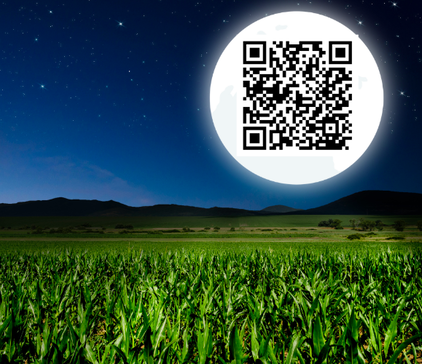 Gardening and Gaiety Under the Moon If you have ever picked up a copy of The Farmer’s Almanac you may have noticed they talk about the Moon a lot more than you would expect for a gardening guide. That is because many folks who have been in the farming and gardening business follow the practice of letting the phase of the Moon determine how and when they plant their food and flowers! More than just a phase, this practice has been in use for ages and despite its mystical seeming nature, many modern farmers swear by the process as well. Part of the appeal is that it is a simple process and can give you the feeling of having some control over your crop yield which, as we all know, can be unpredictable at times. The basic idea behind gardening by the Moon is that the cycles of the Moon affect plant growth. Just as the Moon’s gravitational pull causes tides to rise and fall, it also affects moisture in the soil. In theory, seeds will absorb more water during the full Moon and the new Moon, when more moisture is pulled to the soil surface. This would cause seeds to swell, resulting in greater germination and better-established plants. While there is no hard scientific evidence proving this method works for the reasons listed, the gardeners that have been using this method for generations will tell you that the proof is in the pudding. (Or maybe it’s in the produce.) Those who follow this practice consider it best to plant certain types of plants during the waning of the Moon (when the Moon gets smaller) and other types during the waxing (when the Moon is filling back up). Practitioners of moon phase planting tend to plant their annual flowers and their fruits and vegetables that grow their food above ground (tomatoes, corn, watermelon, squash. etc) during the waxing of the moon. The waning of the moon is the time to plant flowering bulbs, biennial and perennial flowers, and vegetables that develop crops below ground (onions, potatoes, carrots, radishes, etc.) And while these methods of planting by moon phases haven’t been proven scientifically, we can tell you one thing for sure. This upcoming full Moon on Saturday, October 28th, will be the perfect time to plant your derriére in one of the seats at The Backyard Soirée! Join Downtown Greens for delicious food, drinks, and fun as we raise money for our community greenspace. The event includes live music, hors d'oeuvres by FoodE, fire-pits, the amazing Suzie Anker behind the bar, and so much more. On stage will be Harry Wilson, Eddie and the Peacemakers, Gaye Adegbalola, and Ladia. In addition to the cash bar, there will be a silent auction and Oddbox photo booth will be there to document all the fun. Enjoy a VIP package with friends that includes a private fire pit, smore's kit, and two free drink tickets per person for four people. Get your ticket today and help raise funds while having a blast under the light of the Hunter Moon! Event sponsorships available! Lock in your tickets by using the QR code in the picture above or by going to www.downtowngreens.org/backyard-soiree Janet Douberly is Media Manager at Downtown Greens.
0 Comments
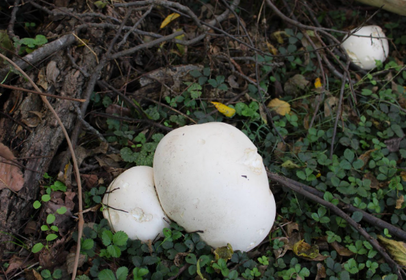 Flora nor Fauna Late summer and early fall are the best time in Virginia for lovers of the Giant Puffball! Giant Puffballs are mushrooms tend to be the mushroom that is most tempting to kick! If it didn’t want to be kicked, why does it look like a ball? If you see a giant puffball in the wild, wait before you kick! If the puffball is still white, it has not created its spores yet so kicking it will not help it reproduce (and won’t be as satisfying). If the puffball has turned brown go ahead and let that kick fly! A pure white giant puffball is actually a prime specimen to pick, not kick. Giant puffballs are huge, soft and edible! Often called the “tofu of mushrooms” because of its almost complete lack of flavor, giant puffballs can be sliced, diced, sauced, marinated, roasted, fried, and boiled for your eating satisfaction. Not only are they good eating (once heavily seasoned) but they are also an excellent source of potassium and many antioxidants! In fact some studies have shown that they also have antibacterial and antiviral properties. As with any foraging, do not eat any plant or fungus that you are not 100% sure of its identity. Giant Puffballs tend to look exactly as the name states. They have no visible gills, caps, or stems and tend to look like golf balls or volleyballs on the ground. Janet Douberly tends to look exactly as the name states at Downtown Greens. 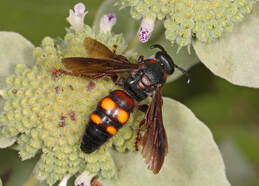 Our Helpful Friends Wasps again?!?! Yes. Wasps again. Hear me out… In the past month or so you may have noticed a bunch of wasps flying around in circles low to the ground for seemingly no reason. If so, you have probably witnessed the scoliid (sko-LEE-ud) wasp! For gardeners in the know, the sight of these wasps brings a sense of joy, or at least grim satisfaction. They know the scoliid wasp is a predator of many of the pests that drive us insane including May bugs, June beetles, and the awful and invasive Japanese beetle. While the adult wasps are usually only spotted when they are above ground drinking nectar from flowers (and also pollinating them in the process), they can also be seen flying low above the ground. They do this when they are hunting! The female wasps fly low “looking” for the grubs of the pests they love so much. Once one is located she digs down to find it and using her ovipositor (the stinger) she injects her eggs inside the grub. The eggs, once hatched, release the larvae of the wasp which then feeds on the grub from the inside, thus killing it and keeping it from eating our lawn, flowers, and gardens. And while the female can sting, she is not aggressive and will only sting if being mishandled. (Who among us doesn’t?) The males cannot sting and they spend most of their time eating nectar and chillin’. Janet Douberly runs PR for wasps at Downtown Greens. This article was originally published in the September 2023 edition of Front Porch Magazine. Check out the full edition by using the button below! 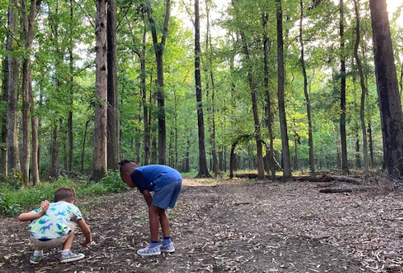 Growth and Possibilities If you haven’t had the chance to join us on a tour of the land at 1360 Belman road, you’re missing out. Since Downtown Greens took ownership of some of the last undeveloped land in the city in 2021, a lot has changed. You would be struck by how much the trees have grown in the short time since volunteers planted more than 800 native saplings back in April. They went in as little bare root sticks, as big around as a pencil and have, in four short months, set roots, leafed out, and are nearly bursting from the tubes in which they were planted. The growth around this field serves as a reminder of the natural growth of the land purchase campaign itself. It’s the story that we all know by now, of a community who came together in a very big way for the benefit of the whole. More than 500 people who all saw the potential and necessity of saving this pristine land full of natural wetlands and agricultural fields. They chipped in over four short months to raise enough money to make it possible to purchase the land, plant trees, host university research classes, and lay the groundwork for all the young people who will be able to learn about sustainable agriculture there. And this was just the beginning! Phase two will start later this year with studies, master site plan renderings for the entire 56 acres and sketches of the built spaces like educational buildings as well as the natural spaces like wetland pathways. But before we can begin in earnest, we need to clear the remaining debt on the land. We only have $70,500 remaining before we own these acres outright! This seems like a huge number on its own. But considering that this community has raised over $2 million dollars in donations, grants, and more, this is a drop in the bucket. Eliminating this debt means that we’re free to build out the potential of the land and more quickly provide services back to our neighbors. The longer it takes us to pay off the debt, the more money we're spending in interest which isn't going toward our mission. If you want to help us cross the finish line and leave your mark on this soon-to-be preserved piece of Fredericksburg’s natural landscape - donate at Downtowngreens.org. Anything will help as we all come together in this last big push. All gifts of $10,000 and more will get your name (or a loved one’s name) on the gratitude rock that will be placed at the entrance of the property. In the meantime, we’re awaiting the approval of our comprehensive plan amendment request at City Council and the Planning Commission to allow us to move forward with a Conservation Easement. We are hoping to record the easement by the end of September. With an Easement in place this land will be preserved in perpetuity and will be available for the public to enjoy for decades to come. Check out what all the fuss is about and join us on our next walkaround tour of the land on Thursday, September 14 at 5pm. Email [email protected] to RSVP. Enjoy an hour-long tour around the property. Refreshing drinks provided. Corey Fillault is Office Coordinator at Downtown Greens This article was originally published in the September 2023 edition of Front Porch Magazine. Use link below to view whole publication. 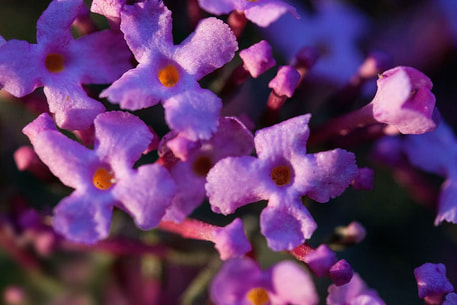 Deceptively Beautiful We’ve all seen the beautiful site a Butterfly Bush can be in the summer. With its conical purple flowers springing outward, attracting dozens of butterflies that flit around it quite quaintly, no one would ever think that this plant is causing a big problem! Butterfly Bush or ‘Buddleja davidii’ are an invasive species of deciduous shrubs that originate from central China. Growing up to 15’ tall, it blooms from mid-summer to early fall. Butterfly Bush is excellent at reproduction, giving it an advantage over our native flowering shrubs and crowding them out. Each flower spike on the plant releases over 40,000 seeds. These light weight seeds travel far by way of water or wind with a +80% germination rate! And while butterflies love all the nectar produced by the copious flowers, that nectar is only feeding the butterflies during one part of their life cycle. The Butterfly Bush does not play host to any of our native insects! Meaning our native butterflies cannot lay their eggs on it and the caterpillars cannot eat the plant. That’s not to say this shrub doesn’t play hosts to ANY insects. The hated and invasive stink bug loves these shrubs and uses them to host their larvae and spread their numbers. If you have a butterfly bush in your garden, consider replacing it with a beautiful native shrub, or at least a non-invasive variant, that will play a true host to our native butterflies Janet Douberly attracts dozens of butterflies at Downtown Greens. This article was originally published in the August 2023 edition of Front Porch Magazine. Use the button below to see the full edition. 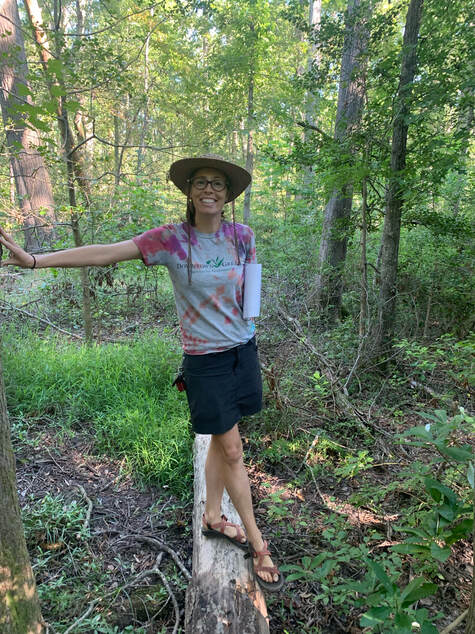 Thank You and Farewell Sarah Perry, our Executive Director for 10 years, is moving on! While we will miss her, we are grateful for the time, sweat, and tears she has put into our organization. We know she is going to do great things! We managed to grab her for a few minutes to ask her a few things about her time here… Proudest moment? The first Youth Farm Program Dinner. Watching the kids proudly making and serving food that they grew to their families still brings tears to my eyes. It was so rewarding. What goals did you achieve? I saw the potential of the space and the opportunity to engage with our community through youth programming and other programs. Favorite Programs DTG? Currently the Cocktail Workshop series. Past favorites are the rain barrel class with Friends of the Rappahannock, cheese workshop with DeLaura, the Ayurveda class, too many to name. Our programs are community driven. If you can dream it, you can do it. Hopes for the future of DTG? Too many to list but seeing the New Land fill its potential and become an even bigger benefit to the community is definitely one. Biggest Lesson Learned? Patience. Everything takes time. Now let’s hear a few words from the lady herself… It is with bittersweet feelings that I announce that I will be stepping down from my position as Executive Director of Downtown Greens in September of this year. Downtown Greens has always been much more than just a job for me, it has been my passion. The people and mission will remain a permanent and very cherished part of my life. It’s been such a joy to witness the positive effects of youth and adult programming thanks to our talented educators bringing people closer to nature and the food that they eat. At its base, though, the garden is a community space and respite, a forever-protected urban oasis for all to enjoy. One seven-year-old neighbor who I met when I first arrived on the job, reminisced, 10 years later, “I could never forget the one place where I always felt comfortable and free.” I am excited for the future of Downtown Greens. I will forever be grateful for the many volunteers who helped and the 520 donors who came together, even when many thought we couldn’t do it, to raise the capital needed to secure Downtown Greens’ new 56-acre parcel of land in the City of Fredericksburg. Saving the land from development was a forever accomplishment that will endure for generations to come. The newly acquired land creates a strong foundation into which the organization can grow its mission and vision. I believe deeply in this organization and its mission. I am confident that the next person who steps into this role will come in with fresh ideas and energy and will be able to take DTG to the next level. It was an honor to serve as executive director for the past 10 years. I’m proud of how far we’ve come and I’m excited to see what’s next. Thank you to the staff, board of directors-past and present, volunteers, donors, grantors, neighbors and children for support, guidance, company, fun and friendship. With Gratitude, Sarah Perry Janet Douberly is excited for the future at Downtown Greens. This article was originally published in the August 2023 edition of Front {porch Magazine. Use the button below to see the full edition. 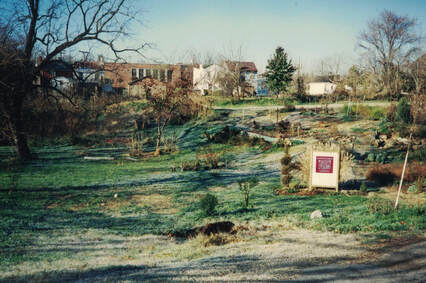 Mission, Vision, Values Downtown Greens began when Laura Shepherd planted a garden on the unused land behind her home at 206 Charles Street (now Downtown Greens offices), inspiring the curiosity of neighborhood children. With the help of Lisa Biever, Eric Olsen and Mark Jacobson, Laura established Downtown Greens as a nonprofit organization in 1995. Its nonprofit status helped Downtown Greens purchase the land behind 206 Charles Street, which became known as the Lower Garden. Four years later, an additional parcel of land across the street at Princess Anne and Dixon Streets was purchased creating what is now referred to as the Upper Garden. Thus a little baby garden began to grow up. Flash forward to 2013. Sarah Perry, dancer, clown, volunteer, and all ‘round swell person, took over the Executive Director position. She continued to run the organization and gardens with the help of staff, volunteers, and community members. The entire 2.8 acres was placed under conservation easement in 2015 to conserve it in perpetuity. The young garden was gaining strength, reach, and knowledge. We were hitting our teen years! Now, 10 years later, we have a larger staff and a LOT more land. The addition of the new 56 acres has made us look around and realize how far this little organization has come! With all the changes and growth happening, Sarah and our amazing Board Members knew it was time to take a moment to look at where we’ve been, where we are, and where we are headed. With that in mind, they have created our newly updated mission statement that really hones in on what Downtown Greens is all about. They have also created a vision statement and defined our values. What does this mean? A Mission Statement is important as it accurately defines our organization's guiding principles. Our Vision Statement is a description of the desired future state of, not only the organization, but also the community and, dare we say, the world. Our Values represent our core beliefs that inspire and guide our choices in the way we operate and interact with our community. We look forward to bringing this organization to the next level and spreading the good word for many years to come. Please allow us to share with you our updated Mission, Vision, and Values… Mission statement: To enhance the well-being of our community, by connecting people with nature through education and the preservation of greenspaces. Vision statement: One day, we will live in a world where the community feels a deep connection with each other,nature, and the food they eat. Values: ● Sustainability- We are intentional in the use of all resources and mindful of how our actions impact the community and the world. ● Inclusion - We honor diversity by respecting the innate worth of all persons, cultures, and abilities. We are stronger because of the varied contributions of all. ● Stewardship – We accept responsibility to care for the land and to educate and encourage the community to become active contributors to a healthy environment. ● Optimism – We believe in our community, and the ability to bring change for the better through our actions, words, and intentions. ● Service – We dedicate ourselves to creating opportunities for the advancement of the community. Janet Douberly is proud to be on the team at Downtown Greens. This article was originally published in the July 2023 edition of Front Porch Magazine. Read the full publication by using the link below.  The Worst Berry Berry Bugs. In the UK they are referred to as Harvest Mites. Here in the states we call the Chiggers. No matter what you call them, we can all agree they are terrible. It’s that time of year again. Time when these horrible little beasts wait patiently for some unsuspecting person or animal to walk by their perch so that they may reach out and ruin someone’s day… and week. From the family trombiculidae, they live in forests and grasslands and most places there is vegetation. They are most numerous in early summer when grass, weeds, and other vegetation are heaviest. In their larval stage, they crawl onto their hosts and inject digestive enzymes into the skin that break down skin cells. They do not actually "bite", but instead form a hole in the skin, called a stylostome, and chew up tiny parts of the inner skin. This causes severe irritation and itching. These relatives of ticks are nearly microscopic, measuring 1/60 of an inch, and have a red to orange color. If they weren’t so horrific they would be pretty. Alas, by the time most humans start to itch, the larvae have already gotten what they needed and have fallen onto the ground to continue their life cycle. Alas, no need to cover yourself in fingernail polish! A hot shower and topical medicines help with the itching and the skin should heal itself within a week or two! Janet Douberly has not encountered any chiggers at Downtown Greens. This article was originally published in the July 2023 edition of Front Porch Magazine. Read the full publication by using the link below. 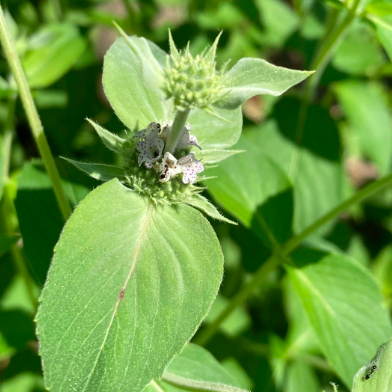 Mint to Be A polite mint that spreads slowly and won't take over the whole garden?!? Mountain Mint, or 'Pycnanthemum muticum' is a Virginia native plant and member of the mint family (lamiaceae). It was first discovered by the French botanist Andre Michaux in 1790, when he found masses of the plant growing in Pennsylvania. Although the common name is Mountain Mint, it actually does not grow in mountainous regions, but rather in open, moist fields and forest edges, often located along the lower elevations of a mountain. And while it is a mint and will do a bit of spreading, it is a great ‘weed-suppressing’ plant and does not spread as invasively as other common mint plants. The flowers open over a 3 month period beginning in June and are a great source of nectar for bees, beneficial wasps, moths and butterflies! In fact, it is rare that the plants are not a flurry of activity when in bloom. Much like a typical mint, the foliage is very aromatic when rubbed and is popular in teas and salads. It is also very effective at repelling mosquitoes when rubbed on the skin. This aroma is also a useful tool in eliminating deer browse! This plant is a great addition to any beds that are MINT to feed the pollinators! Want to check it out for yourself? Come to Downtown Greens in the lower garden by the stone circle and grab a whiff! Janet Douberly won’t take over the whole garden at Downtown Greens. This article was originally published in the June 2023 edition of Front Porch Magazine. Read the full publication by using the link below. 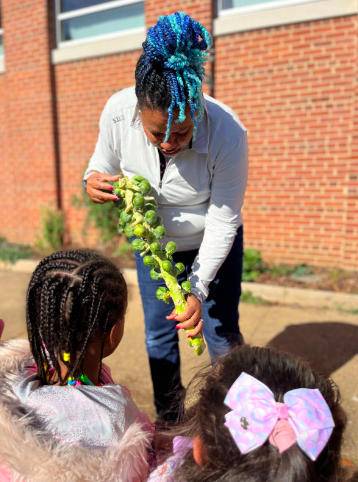 Garden Sprouts At the Walker Grant Building they have a flower and vegetable garden for the children. It's sensory oriented, they get to touch, smell, harvest and taste what they grow. This garden is a bit different from surrounding gardens that are close by. It's tucked away in the back corner of the Walker Grant building on the preschool side and it's a Microclimate. What's a Microclimate? The dictionary defines a micro climate as a small or restricted area, especially when this differs from the climate of the surrounding area. Basically, it's a lot warmer in that corner because of the brick wall and large windows from the classroom and gym. This allows the garden to flourish when others in the neighborhood are dormant or no longer producing. The slightly higher temperature in this area can be good and bad. The good is what the children get to see. They've witnessed strawberries flower and ripen in December. Tomatoes are still being harvested up until mid November after Autumn's first frost has claimed others. Some of the leafy greens will survive the winter, the closer they are to the wall. It's like a cozy blanket keeping them warm in the cold. Many root vegetables stay snug and yummy tucked away in the soil all winter. With all the warmth this area produces for the garden in the cool Autumn and winter months, when spring and summer rolls around it produces a heat that feels like a million suns bearing down on you. The temperature can sometimes feel double of what it actually is, even on a day of 60-70 degrees the garden can feel the heat and it begins to show through the plants. This produces something the children get to see that many people don’t. Most of the vegetables in the garden don’t always get harvested in time and if we have a warm weekend or a holiday some of the vegetables go into survival mode.What do I mean? The children will come back and see the carrots and radishes they planted grow tall and begin to flower, from this they learn where the seeds come from. Who knew Radishes created seed pods for their seed and carrots are in the queens anne's lace family and produces a really pretty flower? They see Brussel sprouts grow tall and the flower buds resemble Broccoli, of course they do because they're in the same plant family and Broccoli is a flower that we eat. How exciting! Once that bud opens up its pretty yellow flowers, the bees buzz all over and enjoy. The small salad green arugula that many of us love for its spicy kick in our salads and on our pizza can grow to a massive bush and produces the prettiest pale yellow flower that turns into long pods filled with seeds. They'll grow, dry out and pop open and fall to become our volunteer plants for the next fall season's arugula, and will survive the winter in the garden. Khalilah Brooker is a Garden Educator at Downtown Greens. She works closely with the children in the Garden Sprouts Program and the Youth Farm Program. This article was originally published in the June 2023 edition of Front Porch Magazine. Read the full publication by using the link below. |
AuthorWrite something about yourself. No need to be fancy, just an overview. Archives
February 2024
Categories |
 RSS Feed
RSS Feed